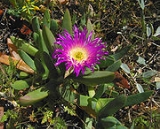
Carpobrotus chilensis
Encyclopedia
Carpobrotus chilensis is a species of succulent plant
known by the common name sea fig. It is probably native to southern Africa but is familiar elsewhere, particularly the coastline of western North America, where it is an invasive introduced species
that has taken hold and become commonplace. It is also found in parts of South America. It is similar to, and often mistaken for, its close relative ice plant (Carpobrotus edulis) which grows alongside and sometimes hybridizes with it. Sea fig has long stems and fleshy, pointed leaves which are triangular in cross-section. Its flowers are magenta and are smaller than those of ice plant. Like ice plant, this species is hardy and can withstand the disturbance by humans which is common on the well-traveled beaches where it grows. This trait gives it an advantage over many native flora species causing it to become a threat to native coastal ecosystems where it has invaded.
Succulent plant
Succulent plants, also known as succulents or fat plants, are water-retaining plants adapted to arid climates or soil conditions. Succulent plants store water in their leaves, stems, and also in roots...
known by the common name sea fig. It is probably native to southern Africa but is familiar elsewhere, particularly the coastline of western North America, where it is an invasive introduced species
Introduced species
An introduced species — or neozoon, alien, exotic, non-indigenous, or non-native species, or simply an introduction, is a species living outside its indigenous or native distributional range, and has arrived in an ecosystem or plant community by human activity, either deliberate or accidental...
that has taken hold and become commonplace. It is also found in parts of South America. It is similar to, and often mistaken for, its close relative ice plant (Carpobrotus edulis) which grows alongside and sometimes hybridizes with it. Sea fig has long stems and fleshy, pointed leaves which are triangular in cross-section. Its flowers are magenta and are smaller than those of ice plant. Like ice plant, this species is hardy and can withstand the disturbance by humans which is common on the well-traveled beaches where it grows. This trait gives it an advantage over many native flora species causing it to become a threat to native coastal ecosystems where it has invaded.

